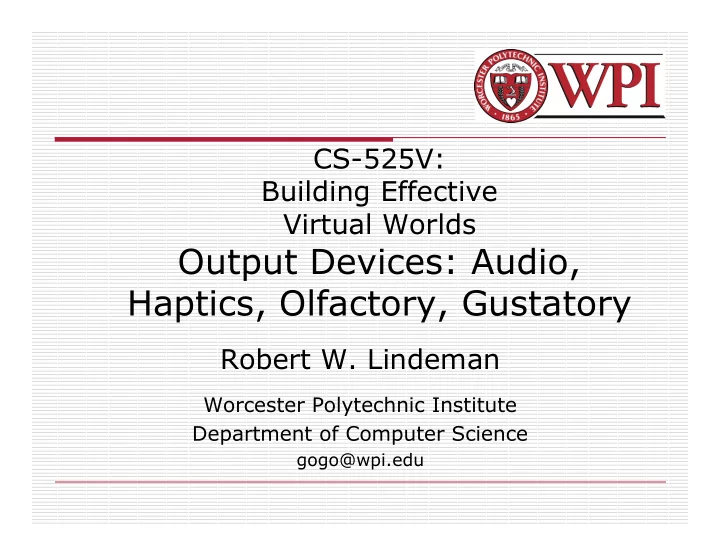

CS-525V: Building Effective Virtual Worlds Output Devices: Audio, Haptics, Olfactory, Gustatory Robert W. Lindeman Worcester Polytechnic Institute Department of Computer Science gogo@wpi.edu
Overview Here we are concerned with technology for stimulating the senses R.W. Lindeman - WPI Dept. of Computer Science 2
Audio Displays Spatialization vs. Localization Spatialization is the processing of sound signals to make them emenate from a point in space Localization is the ability of people to identify the source position of a sound R.W. Lindeman - WPI Dept. of Computer Science 3
Audio Display Properties Presentation Properties Logistical Properties Noise pollution Number of channels User mobility Sound stage Interface with tracking Localization Environmental Masking requirements Integration Amplification Portability Throughput Cumber Safety Cost R.W. Lindeman - WPI Dept. of Computer Science 4
Channels & Masking Number of channels Stereo vs. mono vs. quadrophonic 2.1, 5.1, 7.1 Two kinds of masking Louder sounds mask softer ones Physical objects mask sound signal Happens with speakers, but not with headphones R.W. Lindeman - WPI Dept. of Computer Science 5
Audio Displays Head-worn Ear Buds Open Back Bone On Ear Closed Conduction R.W. Lindeman - WPI Dept. of Computer Science 6
Haptic Displays Haptic sense is most complex Tactile Stimuli on the skin Different kinds of mechanoreceptors, each with varying types of sensitivity Temperature Actually part of tactile Kinesthetic Force on the muscles and tendons Proprioception Force feedback Wind Pain R.W. Lindeman - WPI Dept. of Computer Science 7
Haptic Sense The haptic sense is bidirectional Senses the environment Acts on the environment Tight coupling between the two Skin is the largest organ R.W. Lindeman - WPI Dept. of Computer Science 8
Haptic Devices Pin arrays for the finger(s) Force-feedback "arms" "Pager" motors Particle brakes Passive haptics Many devices are application specific Like surgical devices R.W. Lindeman - WPI Dept. of Computer Science 9
Haptic Feedback in VR Tactile: Surface properties Most densely populated area is the fingertip (okay, it's the tongue) Kinesthetic: Muscles, Tendons, etc. Also known as proprioception R.W. Lindeman - WPI Dept. of Computer Science 10
Haptic Sense (cont) Sensitivity varies greatly Body Threshold Distance Site Two-point discrimination Finger 2-3mm Cheek 6mm Nose 7mm Palm 10mm Forehead 15mm Foot 20mm Belly 30mm Forearm 35mm Upper Arm 39mm Back 39mm Shoulder 41mm Thigh 42mm Calf 45mm http://faculty.washington.edu/chudler/chsense.html R.W. Lindeman - WPI Dept. of Computer Science 11
SensAble PHANToM http://www.sensable.com/ R.W. Lindeman - WPI Dept. of Computer Science 12
Immersion CyberGrasp http://www.immersion.com/ R.W. Lindeman - WPI Dept. of Computer Science 13
Passive Haptic Paddle http://www.cs.wpi.edu/~gogo/hive/ R.W. Lindeman - WPI Dept. of Computer Science 14
UNC Being There Project R.W. Lindeman - WPI Dept. of Computer Science 15
Haptic Feedback in VR Virtual contact What should we do when we know that contact has been made with a virtual object? The output of collision detection is the input to virtual contact Cues for understanding the nature of contact with objects are typically over-simplified ( e.g. , sound) Training aids Can we convey additional information using the haptic channel? R.W. Lindeman - WPI Dept. of Computer Science 16
Vibrotactile Cueing Devices Vibrotactile feedback has been incorporated into many devices Can we use this technology to provide scalable, wearable touch cues? R.W. Lindeman - WPI Dept. of Computer Science 17
Vibrotactile Feedback Projects TactaBoard and TactaVest Navy TSAS Project R.W. Lindeman - WPI Dept. of Computer Science 18
Olfactory Sense Two main problems Scent generation Tens of thousands of receptor types Scent delivery Easier problem R.W. Lindeman - WPI Dept. of Computer Science 19
Air Cannon (Yanagida, 2004) R.W. Lindeman - WPI Dept. of Computer Science 20
Gustatory Not much research here, but some interesting stuff R.W. Lindeman - WPI Dept. of Computer Science 21
Summary There is lots of cool stuff left to try in order to fool the senses It's an engineering problem It's a human-physiology problem It's a human-perception problem R.W. Lindeman - WPI Dept. of Computer Science 22
Recommend
More recommend